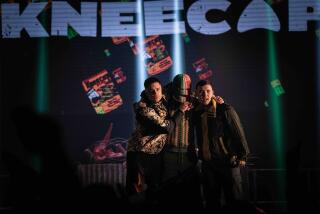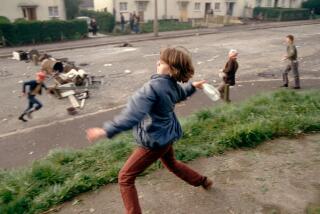Fiddlers, Flutes, Accordians and Ale Combine to Make Beautiful Traditional Music in Pubs
- Share via
Hidden away in Galway’s dock district, the Crane Bar is a plain, two-story gray building with a freshly painted sign announcing “Ceol Music.”
Upstairs, above the main bar, a large, crowded room is minimally furnished with small tables, wooden chairs and benches. The two bartenders are nearly swamped with orders for pints of Guinness, Harp and Smithwick’s.
But the ale and stout are incidental. Most have come for the music: Mick, a tall young man, plays the tin whistle, and Tim, a middle-age man dressed more for California than chilly Ireland in T-shirt and red shorts, plays a button accordion.
I find an empty chair beside a friendly woman. Her husband is drinking Irish whiskey, and she explains the usefulness of poteen, the powerful Irish moonshine whiskey, as a liniment.
“My husband gives me back a good rubbing with it, and the pain goes straight away,” she says.
“Dog trainers swear by it,” her husband says. “They rub it on the dogs’ legs after a race.”
No matter where you go in Ireland your best entertainment bet in the evenings is usually the pub, the center of Irish social life. If you can find pubs that feature “traditional” music, you are guaranteed a wonderful evening for the price of a glass or two of beer.
Unfortunately, there is always a little uncertainty about Irish music. The musicians may arrive late or never or may show up somewhere else.
They aren’t hired by the pub owner; they are playing for their own enjoyment and are very independent. Sometimes they get free drinks and once in a while they’re tipped by the people in the audience. Most of the time they play because they love the music.
The Crane Bar was one of more than a dozen pubs we visited in Ireland on a two-week tour to discover and enjoy Irish traditional music along with the scenery, the friendly people, shopping and, of course, the pubs.
We were guided by Keith and Rusty McNeil of Riverside, professional American folk musicians who also will lead study tours of traditional music and dance of Great Britain, Ireland and France in 1991. They escorted us to villages and remote areas where the best music is found.
A traditional-music gathering in an Irish pub is called a session, and the tunes and songs played have been passed from generation to generation through families and in social gatherings.
The instruments usually include at least one fiddle, a tin whistle or flute, an accordion (called a “box” in Ireland) and occasionally the wonderful, haunting uilleann pipes, which are bagpipes powered by a small bellows tucked under the arm and cranked by the elbow ( uilleann means elbow in Gaelic, the ancient Irish language).
Often someone will have a bodhran , or Irish drum, a goatskin stretched over a wooden ring and played with a two-headed drumstick.
The harp, although historically associated with Ireland, is not likely to be used in a pub session, but the guitar (not a traditional instrument) has become popular, and we saw more guitars than fiddles.
Sometimes a pair of large dinner spoons is used as an effective rhythm instrument. In Tubbercurry, a village near Sligo, the session included two fiddles, flute, tin whistle and spoons.
Sparsely populated western Ireland is poor in productive soil but rich in scenery and language. People converse in Gaelic, especially in Galway, Donegal and the Aran Islands, and road signs are written in English and Gaelic. (When searching for a pub restroom, it’s useful to know that fir means men and mna means women. )
Persistent attempts by the English to stamp out the Irish language and culture were least successful here, and this is where the folk music revival began in the early 1950s.
Ironically, immigrant Irish-American musicians who made recordings in the 1920s and ‘30s greatly influenced this revival, as musicians in Ireland at that time had no access to recording technology.
That has changed. Music tapes are a wonderful way to take your vacation home with you; if a group of musicians hasn’t made a tape of its own, ask them to recommend something. Hundreds of wonderful tapes of Irish music are available.
The search for music is a good excuse to visit picturesque villages such as Dingle, Kenmare and Ennistymon (famous even in Ireland for its many pubs) and pubs such as Gleeson’s in Coor, Connell’s in Knocknagree, Killoran’s in Tubbercurry and the Glencolumbkille Hotel in Donegal.
Age and social barriers don’t exist in pub sessions. In Knocknagree a woman in her 90s played a few jigs on the fiddle while surrounded by children clapping time. Northern Irish Protestants cross the border to play with Irish Catholics.
The Irish love to dance, too, and some of the country pubs we visited were large enough for everyone to join in the dancing, the people happy to show visitors the steps.
Even in the smaller pubs the musicians play mostly dance tunes, an assortment of lively jigs, reels and hornpipes, with an occasional slow air or song to give the musicians a chance to catch their breath.
In country pubs, traditional singing without accompaniment ( sean nos ) is popular. Private conversations and laughter often continue during instrumental sets, but a hush falls over the crowd when a song is begun. With other types of music, singers will accompany themselves with instruments.
Our last night in Ireland was spent at the Barge Inn in Garrykennedy on lovely Lough (Lake) Derg. In the cozy little anteroom, six musicians (two fiddles, two flutes, pipes and bodhran) played to about 15 listeners.
I sat beside a retired policeman from the United States who was (after several pints of stout) persuaded by his friends to sing a couple of poignant Irish songs.
Pub hours are strictly observed. Musicians generally begin to play at 9:30 p.m. and stop about 11:30. Last drink orders must be placed before 11:30, and at midnight the pubs must close.
A little before midnight the owner of the Barge Inn came into the room and announced, “Time, gentlemen!” ignoring the fact that more than half the patrons were women and children.
In protest, some of the customers began singing, “Good Night, Ladies.” When we were finally all out on the sidewalk, one of the women invited us to her house for drinks and coffee. The Irish hate to put an end to a good time.
Combining Tours, Sights
The easiest way to combine sightseeing with the best of Irish traditional music is to take the tour, which is the only one of its kind.
For information, write to Keith and Rusty McNeil, 16230 Van Buren Blvd., Riverside 92504; (714) 780-2322.
Another way to hear traditional music in Ireland is at one of the music festivals, such as the Willy Clancy School in Milltown Malbay.
For information on festivals and other cultural activities, contact the Irish Tourist Board, 757 3rd Ave., 19th Floor, New York 10017, (212) 418-0800.
More to Read
Sign up for The Wild
We’ll help you find the best places to hike, bike and run, as well as the perfect silent spots for meditation and yoga.
You may occasionally receive promotional content from the Los Angeles Times.






